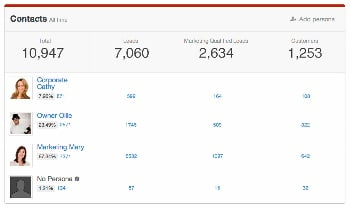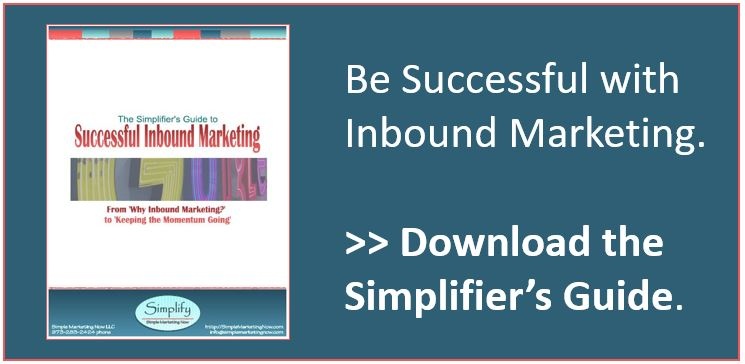.jpg)
Do you do personas in your business? Have you integrated them into your inbound marketing?
If yes, then please add your perspective to this article in the comments.
If no, you'll be interested in the persona tool from HubSpot which makes integrating personas into your inbound marketing not only seamless, but also impossible to ignore.
However, even if you don't use HubSpot, you can apply personas to your marketing, so read on!
What are personas and how do they matter to inbound marketing?
Not all customers are the same. Personas allow you to capture those differences so your marketing can be more relevant to those specific groupings of differences. That in turn enables you to better connect with them. (See The Case for Personas in Business: Connecting With Customers.) It also means they'll be more willing to engage with you because you won't be wasting their time...
Personas are made-up characters that you create for your business based on understanding (and researching) different groupings of customers and detailing their roles, pain points, professional interests and questions. Ideally, you name them and associate a picture of a person with them so you readily visualize them as legitimate entities as you develop marketing materials and make business decisions.
The naming and personification means that your personas are no longer an abstraction; instead they become a concrete element of everything you do.
-
Only by deliberately considering your customer segments can you create content your customers will love.
-
Only by walking in their shoes can you know what information will be relevant to them.
-
Only by stepping back and considering who does business with you can you notice patterns and differences in the questions you must answer and the solutions you develop as a result.
And then you're able to be deliberate about how to customize and fine-tune your website, your content and your online presence to answer the needs of your personas, which in turn truly supports your overall business strategy.
You may have negative personas
Not all prospects or customers are ideal for your business. By using personas, you can can even identify the ones you'd rather not do business with, and ensure you don't allocate resources needlessly.
Examples that come to mind include wanting to know if someone is a student rather than a business decision-maker, or that someone can't afford your solution.
I suspect you can identify situations that are specific to your own business.
Whether positive or negative, by understanding which customer persona reaches out to you on contact forms, via email or in person, you can better customize your communications. You can segment based on commonality to be more relevant in your messaging.
Examples of personas in business
Another way to look at personas is by thinking about how you segment your customer base.
-
In my previous life in the acrylic and nylon fiber manufacturing businesses, I dealt with direct customers - yarn spinners - who sold to fabric mills who then sold to garment manufacturers or furniture manufacturers who sold to retailers and then to the final end consumer. Each of those distribution chain levels could be a distinct persona. I spoke differently to each group; I developed distinct programs for each. They were all part of my business; what worked for one didn't for the other.
-
Some businesses may sell to residential customers as well as to commercial entities.
-
Others may have to deal with several distinct functional groups within a large operation - a hospital for example.
-
A university has to consider applicants, enrolled students, their parents, faculty, donors as well as alumni.
Personas will definitely vary depending on the nature of your business. By understanding these different groups, you'll be better able to satisfy their needs and personas make it 'personal.' They help you deliberately think about your customer and market segments and how you contribute value.
What about using the HubSpot Persona Tool so you can embrace inbound marketing?
Personas, though, can remain abstract - almost like an Elf on the Shelf. They keep you on track, but they aren't necessarily fully integrated into data analysis.
The HubSpot persona tool changes that. It gets you to identify a persona description that you can use in your download forms so visitors self-select the most relevant persona for themselves.
 Now, you still need to go through your existing database and figure things out. Identifying those relevant persona descriptions takes thoughtfulness and a deep understanding of your business. You'll want to slog through to understand the makeup of your database. As intense a project as that is, I guarantee you'll discover amazing patterns from doing so!
Now, you still need to go through your existing database and figure things out. Identifying those relevant persona descriptions takes thoughtfulness and a deep understanding of your business. You'll want to slog through to understand the makeup of your database. As intense a project as that is, I guarantee you'll discover amazing patterns from doing so!
But at some point you'll be ready to enroll your existing contacts in an email campaign with an irresistible offer which includes the persona tool question as part of the form... allowing the inbound magic to develop.
Once you have accurate personas, imagine the difference in the communications you can create. Email open rates and click rates take on new meaning. Knowing who you are speaking with makes marketing more interesting.
Furthermore, it sets off an exciting series of next steps to determine how to better meet your personas' information needs with your website content, blog content, social updates and marketing offers. You can now focus on better understanding those prospects and contacts so you convert them, delight them, and develop meaningful relationships with them.
No HubSpot persona tool? You can still integrate them into your inbound marketing!
That said, if you don't have HubSpot, don't despair! You can still implement personas. Here's how:
1. Look from a big picture perspective at your business. What types of people do your contacts represent? Are they all customers? Do you speak to all of them the same way or do you have different messages depending on specific characteristics?
2. Observe the major differences: are some distributors, others dealers, and others specifiers and end users? How do you know what makes one different from the other?
3. Identify 4 or 5 buckets of differences.
4. Place each person in your contact database into one of those buckets. At times this will be challenging because some people have different roles. When that happens, develop rules that you can apply consistently.
5. Add a question to your form that helps you identify one or more of your personas. These can be descriptors that your prospect self-selects - making it easier to categorize contacts.
6. Create a persona property in your contacts database and complete that field for your contacts.
7. Develop a system for regularly reviewing new additions and apply the persona rules.
8. Develop communications (web content, blog content, offers, etc.) specifically tailored to that persona.
9. See what develops. Make adjustments.
How Do You Use Personas in your Business?
If you use personas, how do you identify them? What are some successes you've had that capture why every business should embrace personas?
Thanks for reading!
Image credit: Personas on Flickr.com
Note: This article was originally published on March 26, 2014 and has been updated.









